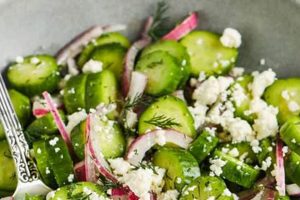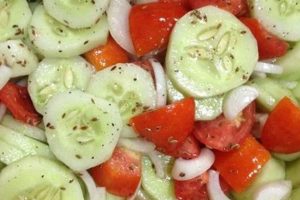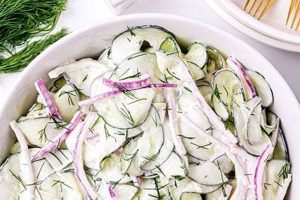A refreshing and light dish, typically comprised of thinly sliced cucumbers combined with other ingredients such as onions, herbs, and a vinaigrette dressing. Variations can include additions like tomatoes, feta cheese, or dill. A simple example features thinly sliced cucumbers tossed with red onion, white vinegar, sugar, salt, and pepper.
This type of salad offers several advantages, particularly during warmer months. Its high water content provides hydration, while the simple ingredients contribute to a low-calorie, nutrient-rich meal. Historically, cucumbers have been cultivated for thousands of years, and their use in salads likely evolved alongside culinary traditions in various regions. The emphasis on fresh, seasonal produce makes these salads a popular choice for summer meals.
The following sections will explore specific variations of this salad, offering detailed instructions, ingredient lists, and tips for optimal preparation. Nutritional information and potential health benefits will also be discussed.
Tips for Preparing a Refreshing Cucumber Salad
Achieving optimal flavor and texture requires attention to detail. The following tips offer guidance for creating a successful and enjoyable culinary experience.
Tip 1: Choose the Right Cucumbers: Select firm cucumbers with smooth skin. English cucumbers are ideal due to their thin skin and minimal seeds. For a milder flavor, peel conventional cucumbers before slicing.
Tip 2: Slice Cucumbers Thinly and Uniformly: Thin slices ensure even marinating and a delicate texture. A mandoline slicer or sharp knife can achieve consistent results.
Tip 3: Salt and Drain Excess Moisture: Salting the sliced cucumbers draws out excess water, preventing a watery salad. Allow the cucumbers to sit for 15-20 minutes, then pat dry with a clean towel.
Tip 4: Balance Flavors with Acidity: Vinegar or citrus juice adds brightness and balances the cucumber’s subtle sweetness. Experiment with different types of vinegar, such as white wine, rice, or apple cider vinegar.
Tip 5: Incorporate Fresh Herbs: Dill, mint, and parsley complement cucumbers well. Chop the herbs finely and add them just before serving to maximize their flavor.
Tip 6: Enhance Texture with Optional Additions: Thinly sliced red onion adds a pungent bite, while crumbled feta cheese or toasted nuts offer contrasting textures.
Tip 7: Chill Before Serving: Chilling the salad allows the flavors to meld and enhances the refreshing qualities. Refrigerate for at least 30 minutes before serving.
By following these tips, one can create a flavorful and visually appealing salad that complements a variety of meals. Proper preparation techniques ensure a satisfying culinary experience.
The following section will offer several recipe variations incorporating these tips, providing options for diverse palates and dietary preferences.
1. Fresh Cucumbers
Fresh cucumbers are fundamental to a successful summer cucumber salad. Their crisp texture and mild, refreshing flavor provide the base upon which the other ingredients build. Using less-than-fresh cucumbers results in a compromised final product; the salad can become watery, mushy, and lacking in vibrancy. The choice of cucumber also influences the overall taste. For instance, English cucumbers, known for their thin skin and minimal seeds, offer a delicate flavor and avoid the need for peeling. Conversely, garden cucumbers, with thicker skins and more seeds, may require peeling and seeding to prevent bitterness and excess water in the salad.
The freshness of cucumbers directly impacts the salad’s overall quality. A fresh cucumber offers a satisfying crunch, contributing to the textural appeal. Furthermore, its inherent water content contributes to the hydrating and refreshing nature of the dish, particularly beneficial during hot summer months. Consider a scenario where wilted cucumbers are used: the salad lacks the desired crispness, and the flavor profile is muted. This highlights the crucial role of fresh cucumbers in achieving the intended sensory experience.
Selecting and preparing fresh cucumbers appropriately is essential for a successful summer cucumber salad. Opting for firm, unblemished cucumbers and employing proper storage techniques helps maintain their freshness. Thoroughly washing and, if necessary, peeling and seeding the cucumbers ensures optimal texture and flavor. Understanding the importance of fresh cucumbers allows for informed decisions during ingredient selection and preparation, ultimately leading to a more enjoyable and satisfying culinary outcome.
2. Light vinaigrette
A light vinaigrette plays a crucial role in a successful summer cucumber salad recipe. The vinaigrette provides the acidic component necessary to balance the cucumber’s subtle sweetness and enhance its inherent refreshing qualities. A heavy, creamy dressing would overpower the delicate cucumber flavor and compromise the salad’s light and summery character. The vinaigrette’s acidity also contributes to preserving the cucumbers’ crisp texture, preventing them from becoming soggy. For instance, a simple vinaigrette of white wine vinegar, olive oil, salt, and pepper provides a bright counterpoint to the cucumber, enhancing its flavor without masking it.
The choice of vinaigrette significantly impacts the overall flavor profile. A lemon vinaigrette offers a zesty, citrusy note, while a rice wine vinegar vinaigrette lends a subtly sweet and tangy flavor. Herbs and spices can be incorporated into the vinaigrette to further complement the cucumber. Dill, mint, and chives are popular choices, adding layers of aromatic complexity. Furthermore, the vinaigrette acts as a unifying element, binding the other ingredients together and creating a harmonious flavor experience. Consider a salad with cucumbers, red onion, and feta cheese: the vinaigrette coats each ingredient, allowing their individual flavors to meld and create a cohesive whole.
Understanding the function and impact of a light vinaigrette is essential for crafting a well-balanced and flavorful summer cucumber salad. The vinaigrette not only complements the cucumber’s flavor but also contributes to the salad’s overall texture and appeal. Careful selection of ingredients and balanced proportions are key to achieving the desired result. A properly executed light vinaigrette elevates the simple cucumber salad from a basic side dish to a refreshing and flavorful culinary experience.
3. Complementary Herbs
Complementary herbs are essential for elevating a summer cucumber salad from simple to exceptional. Their aromatic and flavor profiles interact with the cucumber’s mildness, creating a more complex and nuanced sensory experience. The choice of herbs significantly influences the final taste; for instance, dill provides a bright, slightly tangy flavor that pairs well with cucumbers, while mint adds a refreshing coolness. Other suitable herbs include parsley, chives, and tarragon. The quantity of herbs used also matters; too much can overpower the delicate cucumber flavor, while too little may not provide sufficient complexity. A judicious balance is key to a harmonious result. Consider a salad with cucumbers, red onion, and a lemon vinaigrette: the addition of fresh dill complements the other flavors, creating a vibrant, balanced dish.
The practical application of this knowledge involves careful selection and preparation of the herbs. Fresh herbs are preferred over dried, as they offer a more intense flavor and aroma. They should be washed, dried, and chopped finely just before adding to the salad to maximize their impact. Incorporating herbs directly into the vinaigrette allows their flavors to infuse the dressing, further enhancing the overall taste. Overusing strong herbs like mint can overwhelm the other flavors, highlighting the importance of thoughtful herb selection and portioning. An example of successful herb integration is a cucumber salad with feta cheese, where the salty cheese balances the herbaceous notes of dill or mint.
In summary, complementary herbs are indispensable for a truly delicious summer cucumber salad. Their careful selection and application elevate the dish’s flavor profile, creating a more nuanced and satisfying culinary experience. Understanding the interplay between herbs and other ingredients allows for informed choices, leading to a well-balanced and refreshing summer salad. This knowledge is practically significant for anyone seeking to optimize the flavor and complexity of cucumber-based dishes, demonstrating the transformative potential of herbs in culinary creations.
4. Optional additions
Optional additions offer opportunities to personalize and enhance the flavor and textural complexity of summer cucumber salads. While the foundational elements of cucumbers and a light dressing establish the base, these additions provide avenues for customization, catering to individual preferences and dietary needs. Understanding the role and impact of various optional additions allows for informed choices, resulting in a more satisfying and personalized culinary creation.
- Textural Contrasts
Ingredients that provide textural contrast enhance the sensory experience of a cucumber salad. Toasted nuts, such as slivered almonds or chopped walnuts, introduce a satisfying crunch. Crumbled feta cheese provides a creamy, salty counterpoint to the cucumber’s crispness. Seeds, like sunflower or sesame, offer a subtle nutty flavor and a textural variation. These additions prevent the salad from becoming monotonous, creating a more dynamic and engaging culinary experience. For example, a salad with cucumbers, feta, and toasted almonds offers a combination of crisp, creamy, and crunchy elements.
- Flavor Enhancers
Flavor enhancers broaden the salad’s flavor profile beyond the cucumber’s inherent mildness. Red onion adds a sharp, pungent note, while chopped fresh or dried fruits, such as berries or grapes, introduce sweetness. Incorporating different varieties of peppers, like bell peppers or jalapeos, contributes varying levels of heat and complexity. These additions create a multi-dimensional flavor experience, moving beyond simplicity to a more nuanced and personalized taste. A salad with cucumbers, red onion, and fresh mint offers a refreshing and complex interplay of flavors.
- Protein Integration
Protein additions transform the cucumber salad from a side dish to a more substantial meal. Grilled chicken or shrimp provides a lean protein source, while chickpeas or lentils offer a vegetarian option. These additions contribute to satiety and nutritional value, making the salad a more complete and balanced meal. Consider a cucumber salad with grilled shrimp, avocado, and a lemon vinaigrette: this combination provides a light yet satisfying meal with a balance of protein, healthy fats, and fresh flavors.
- Nutritional Boosters
Incorporating nutritional boosters enhances the health benefits of the salad. Avocado adds healthy fats and creaminess, while sprouts contribute vitamins and minerals. Superfoods like goji berries or chia seeds provide antioxidants and other beneficial nutrients. These additions create a salad that is not only delicious but also nutrient-dense, contributing to overall well-being. A cucumber salad with avocado, sprouts, and a lemon-tahini dressing offers a flavorful and nutritionally rich meal option.
By thoughtfully incorporating optional additions, one can customize summer cucumber salads to suit individual preferences and dietary needs. These additions not only enhance the sensory experience but also contribute to nutritional value and overall meal satisfaction. The careful selection and balance of optional additions elevates the simple cucumber salad to a customizable and versatile culinary creation.
5. Chilling Time
Chilling time is a crucial element in optimizing the flavor and texture of a summer cucumber salad. Adequate chilling allows the flavors of the various componentscucumbers, vinaigrette, herbs, and any additional ingredientsto meld, resulting in a more harmonious and balanced taste. Furthermore, chilling enhances the refreshing quality of the salad, making it particularly appealing during warmer months. This exploration will delve into the multifaceted impact of chilling time on the final product.
- Flavor Development
Chilling allows the vinaigrette to permeate the cucumber slices, infusing them with flavor. This process also allows the flavors of any added herbs or spices to blend more thoroughly with the other ingredients. For instance, a salad chilled for 30 minutes will exhibit a more integrated flavor profile compared to one served immediately after preparation. The extended contact time between ingredients in a chilled environment facilitates a deeper and more nuanced flavor experience.
- Texture Enhancement
Chilling firms the cucumbers, enhancing their crispness. This is particularly important if the cucumbers have been salted to draw out excess moisture, as chilling helps restore their structural integrity. A chilled salad offers a more satisfying textural contrast between the crisp cucumbers and other ingredients, such as creamy feta cheese or crunchy nuts. The absence of adequate chilling can result in a salad with a less appealing, softer texture.
- Temperature and Refreshment
A chilled cucumber salad provides a welcome respite from summer heat. The cool temperature enhances the perception of refreshment, making the salad more enjoyable during warmer months. Serving a cucumber salad at room temperature diminishes its refreshing qualities, particularly in hot weather. The temperature of the salad significantly impacts the overall sensory experience.
- Optimal Chilling Duration
While chilling is beneficial, excessive chilling can be detrimental. Over-chilling can cause the cucumbers to become mushy and lose their desirable texture. A general guideline is to chill the salad for at least 30 minutes, but no longer than two hours, to achieve optimal flavor and texture. The specific chilling time may vary depending on the ingredients and the desired outcome. Striking the right balance is essential for maximizing the salad’s appeal.
In conclusion, chilling time is not merely a perfunctory step but a critical factor that significantly influences the overall quality of a summer cucumber salad. By understanding the impact of chilling on flavor development, texture enhancement, and temperature, one can optimize the preparation process to create a truly refreshing and flavorful culinary experience. A properly chilled cucumber salad offers a delightful combination of crispness, balanced flavors, and refreshing coolness, making it a perfect accompaniment to summer meals.
Frequently Asked Questions
This section addresses common inquiries regarding the preparation and enjoyment of summer cucumber salads.
Question 1: Can one prepare this salad in advance?
Advance preparation is possible, but optimal flavor and texture are achieved when served within two hours of preparation. Longer storage can result in excess moisture release and a less crisp texture. If making ahead, store the salad without the dressing and toss just before serving.
Question 2: What type of vinegar is best suited for the vinaigrette?
Various vinegars complement cucumber salads. White wine vinegar, rice vinegar, and apple cider vinegar are popular options. The specific choice depends on the desired flavor profile. Experimentation is encouraged to discover personal preferences.
Question 3: How can excess moisture in the salad be prevented?
Salting the sliced cucumbers draws out excess moisture. After slicing, sprinkle the cucumbers with salt and let them sit for 15-20 minutes. Gently pat them dry with a clean towel before adding to the salad.
Question 4: Are English cucumbers preferable to other varieties?
English cucumbers, due to their thin skin and minimal seeds, are often preferred. However, other varieties can be used; peeling and seeding might be necessary to mitigate bitterness and excess moisture.
Question 5: What herbs pair well with cucumbers beyond dill?
Mint, parsley, chives, and tarragon are excellent alternatives or additions to dill. The choice of herbs influences the overall flavor profile, so selecting based on personal preference is advised.
Question 6: How can this salad be made more substantial as a main course?
Adding protein, such as grilled chicken, shrimp, chickpeas, or lentils, transforms the salad into a more complete meal. Incorporating grains like quinoa or couscous can further enhance its satiety value.
Understanding these frequently asked questions facilitates successful preparation and enjoyment. Experimentation with ingredients and techniques allows for personalized variations that cater to individual preferences.
The following section provides a selection of tested recipes for various cucumber salad variations, ranging from classic preparations to more innovative combinations.
Summer Cucumber Salad Recipe
This exploration of the summer cucumber salad recipe has highlighted the essential components and techniques for achieving optimal results. From the selection of fresh cucumbers and the creation of a balanced vinaigrette to the incorporation of complementary herbs and optional additions, each element contributes to the final product’s overall quality. The importance of proper chilling to enhance flavor and texture has also been emphasized. Understanding these key factors allows for informed choices during preparation, resulting in a salad that is both refreshing and flavorful.
The simplicity of this dish belies its potential for culinary creativity. The summer cucumber salad offers a versatile canvas for culinary exploration, allowing for endless variations and personalized adaptations. By embracing fresh, seasonal ingredients and mindful preparation techniques, one can elevate this simple salad to a truly delightful culinary experience, showcasing the transformative power of fresh produce and balanced flavors.






